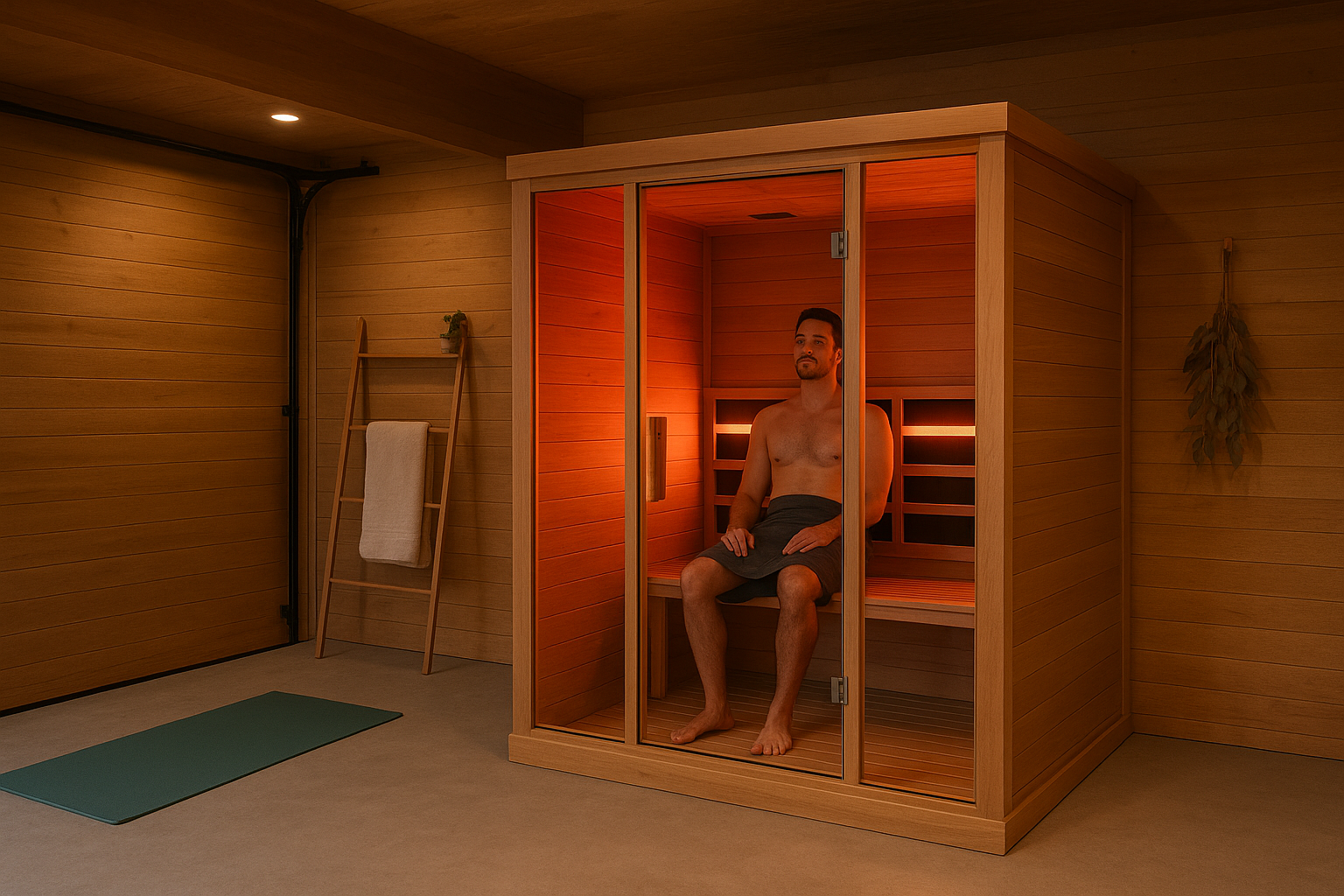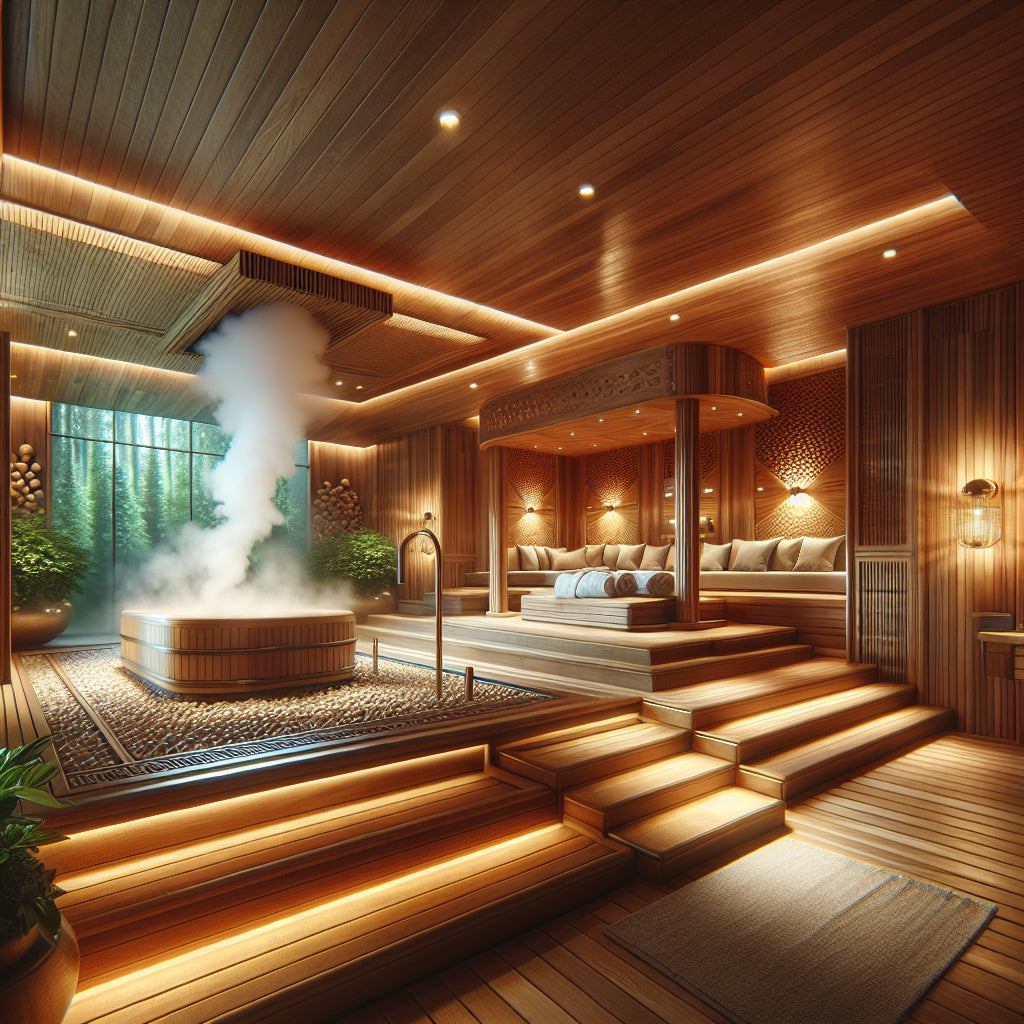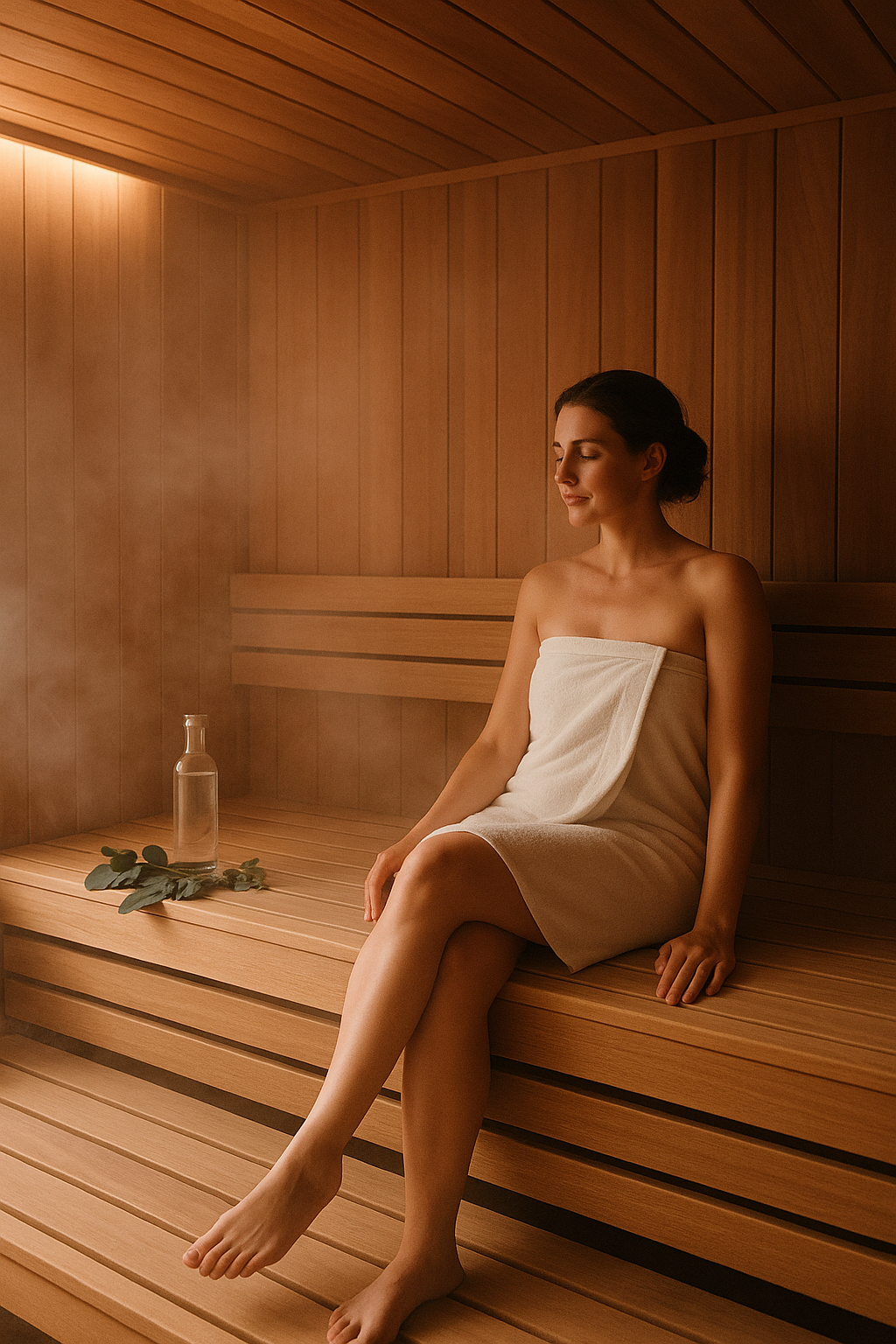Transform Your Garage into a Health-Boosting Sauna Sanctuary
How to Build a Sauna in Your Garage: The Complete 2025 Guide
Picture this: You finish a grueling workout, open your garage door, and step into waves of therapeutic heat. No gym membership required. No driving across town. Just pure, restorative wellness waiting in the space where you used to store forgotten boxes and old paint cans.
Converting your garage into a sauna isn't just clever use of space—it's an investment in your long-term health, home value, and daily quality of life. This comprehensive guide walks you through everything you need to know about building a garage sauna, from health benefits to construction details.
Why Your Garage Is Perfect for a Sauna
Your garage offers advantages that other home spaces simply can't match:
Existing Infrastructure: Most garages already have electrical access, ventilation options through doors or windows, and concrete flooring that handles moisture beautifully. This existing setup dramatically reduces installation complexity and cost.
Privacy and Separation: A garage sauna creates a dedicated wellness space separate from your main living areas. This physical boundary helps establish a true retreat mindset—when you step into your garage sauna, you're mentally entering a healing space.
Flexible Ventilation: Garage doors and windows make temperature regulation effortless. Open them post-session for rapid cooldown, or crack them during winter months for comfortable year-round use regardless of outdoor conditions.
Space Efficiency: Rather than sacrificing a bedroom or converting a basement, you're activating underutilized square footage. The result? A wellness upgrade that doesn't compromise your home's functionality.
Increased Home Value: Wellness amenities appeal strongly to modern buyers. A well-built garage sauna distinguishes your property in competitive markets and can offer significant ROI when you sell.
Science-Backed Health Benefits of Regular Sauna Use
The health benefits of sauna bathing aren't wellness industry hype—they're supported by decades of rigorous research, particularly from Finnish populations where sauna use is a cultural staple.
Cardiovascular and Heart Health
Regular sauna sessions function as passive cardiovascular exercise. Studies show that frequent Finnish-style sauna use significantly lowers blood pressure, reduces arterial stiffness, and decreases the risk of sudden cardiac death. The heat causes your heart rate to increase (similar to moderate exercise), improving circulation and cardiovascular conditioning. When combined with actual physical exercise, these benefits compound dramatically.
Cellular Protection and Longevity
Sauna heat triggers your body's production of heat shock proteins (HSPs)—molecular chaperones that facilitate cellular repair and protect against damage. HSPs contribute to muscle preservation during aging, offer neuroprotection for brain health, and help your body manage various stressors more effectively. This cellular-level benefit may explain why regular sauna users often show markers associated with increased longevity.
Enhanced Recovery and Pain Relief
Athletes and fitness enthusiasts have discovered what research confirms: sauna heat accelerates muscle recovery, reduces post-workout soreness, and improves circulation to aid nutrient delivery and waste removal. The heat also provides natural pain relief by relaxing muscles and increasing endorphin production.
Cognitive Function and Brain Health
Perhaps most compelling, long-term sauna use correlates with reduced risk of Alzheimer's disease and stroke. The mechanism involves improved vascular health, increased production of brain-derived neurotrophic factor (BDNF)—which supports neuron growth and survival—and enhanced blood flow to the brain.
Mental Health and Stress Relief
The psychological benefits are immediate and profound. Sauna heat naturally elevates mood, reduces anxiety, and provides deep relaxation. The BDNF increase mentioned above doesn't just protect neurons—it actively improves mood regulation, memory formation, and stress resilience.
Planning Your Garage Sauna Build
Success starts with thorough planning. Before purchasing materials or equipment, work through these critical considerations:
Space Assessment
Measure your available square footage carefully. A functional sauna for one to two people requires a minimum footprint of 4' × 6', while larger groups need at least 6' × 8'. Don't forget ceiling height—you'll need sufficient clearance for both the sauna structure and proper air circulation above.
Inspect for existing moisture problems, foundation cracks, or drainage issues that need addressing before construction begins. Check ceiling joists and garage floor condition to ensure they can support your sauna installation.
Layout and Flow
Think beyond just the sauna box itself. Plan for:
- Changing area: Where will you undress and store clothes?
- Cooldown zone: A bench or seating area outside the sauna enhances the experience
- Shower access: Proximity to a bathroom or outdoor shower adds convenience
- Storage: Towels, robes, and sauna accessories need dedicated space
Consider positioning your sauna near your garage's existing electrical panel to minimize wiring runs and reduce installation costs.
Sauna Type Selection
Two primary options dominate the garage sauna market:
Traditional Finnish Sauna (Dry Heat)
- Temperatures: 150-195°F
- Uses electric heater with optional steam from water on rocks
- Deeper heat penetration and more intense experience
- Higher initial cost but traditional experience many prefer
- Requires dedicated 220V electrical circuit
Infrared Sauna
- Temperatures: 120-150°F
- Lower operating costs and faster heat-up time
- Gentler heat that some find more comfortable
- Easier DIY installation with lower electrical requirements
- May lack the traditional sauna "feel" purists seek
Both deliver significant health benefits—choose based on your preferences, budget, and electrical capabilities.
Building Your Garage Sauna: Step-by-Step
Step 1: Insulation for Heat Retention
Proper insulation isn't optional—it's essential for safety, efficiency, and effectiveness.
Wall and Ceiling Insulation: Install mineral wool insulation between studs (R-13 minimum for walls, R-19 for ceiling). This provides excellent heat resistance and fire safety. Cover insulation with a vapor barrier to prevent moisture from penetrating into wall cavities, which causes mold and structural damage.
Foil-Backed Board: Add a layer of foil-backed insulation board over the vapor barrier. This reflects heat back into the sauna space, dramatically improving efficiency.
Floor Protection: While your garage's concrete slab provides a water-resistant base, add tile or marine-grade plywood on top for comfort, additional moisture protection, and easier cleaning. Standard wood flooring will warp and deteriorate from heat and humidity.
Step 2: Critical Ventilation Design
Inadequate ventilation is the most common—and most dangerous—mistake in garage sauna construction. Proper airflow prevents oxygen depletion, controls humidity levels, eliminates odors, and prevents mold growth.
Fresh Air Intake: Install a vent low on the wall near your sauna heater. This intake should be roughly 4-6 inches in diameter and positioned to draw fresh air across the heat source, warming it as it enters.
Exhaust Vent: Place an exhaust vent on the opposite wall at ceiling level, or use an existing window with adjustable opening. This creates a convection current—hot, humid air naturally rises and exits while fresh air enters below.
Cross-Ventilation: The system should completely exchange the air in your sauna approximately 6-8 times per hour during use. This continuous but gentle air movement maintains oxygen levels and prevents that stale, suffocating feeling that indicates poor ventilation.
Never seal your sauna completely, even in winter. Always maintain active airflow during sessions.
Step 3: Electrical Installation and Safety
This is not a DIY task unless you're a licensed electrician. Improper electrical work in a sauna environment creates serious fire and electrocution hazards.
Dedicated Circuit: Your sauna heater requires its own dedicated 220V circuit (for traditional saunas) or potentially 110V (for smaller infrared units). This circuit should run directly from your breaker panel with appropriate gauge wire for the heater's amperage requirements.
GFCI Protection: Ground Fault Circuit Interrupter (GFCI) protection is mandatory. This device detects electrical faults and cuts power instantly, preventing electrocution in the humid sauna environment.
Moisture-Proof Components: All wiring, junction boxes, and connections must be rated for high-temperature, high-humidity environments. Use only sauna-rated electrical components.
Code Compliance: Electrical codes for saunas vary by jurisdiction. Your electrician should pull proper permits and schedule inspections to ensure your installation meets local requirements.
Step 4: Interior Construction and Wood Selection
The wood you choose affects durability, heat retention, comfort, and safety.
Recommended Woods:
- Cedar: Naturally resistant to moisture and insects, pleasant aroma, comfortable heat tolerance. Western Red Cedar is the most popular choice.
- Aspen: Light color, minimal odor, stays cooler to the touch than cedar—ideal for benches
- Hemlock: Budget-friendly option with good heat tolerance and durability
Woods to Avoid: Pine and other resinous softwoods can "weep" sap when heated. Treated lumber is absolutely prohibited—chemicals leach out under high heat, creating toxic fumes.
Bench Construction: Build benches at varying heights to accommodate different heat preferences—lower benches are cooler, upper benches provide more intense heat. Use rounded edges and smooth finishes to prevent splinters. Leave gaps between slats for airflow and drainage.
Wall and Ceiling Finishing: Tongue-and-groove boards provide attractive, seamless coverage. Install horizontally or vertically based on aesthetic preference, ensuring proper spacing for wood expansion in heat.
Step 5: Design Enhancements
Transform your functional sauna into a true sanctuary with thoughtful additions:
Lighting: LED strip lights or recessed fixtures rated for sauna use create ambiance. Choose warm color temperatures (2700-3000K) for relaxing atmosphere. Avoid harsh, bright lighting.
Sound System: Bluetooth speakers rated for heat and humidity let you enjoy music, podcasts, or meditation tracks during sessions.
Aromatherapy: Add a sauna-safe essential oil diffuser or simply place drops of eucalyptus, cedar, or lavender oil on a heat-resistant dish near (never directly on) the heater.
Accessories: Consider adding a wooden bucket and ladle for water, a thermometer/hygrometer, backrest cushions, and hooks for towels and robes.
Budget Expectations
Garage sauna costs vary significantly based on size, materials, and whether you choose DIY or professional installation:
DIY Kit Installation: $3,000-$6,000
- Prefabricated sauna kit with pre-cut walls
- Basic electric heater
- Minimal customization
- Your own labor for assembly
Mid-Range Custom Build: $6,000-$10,000
- Custom dimensions and layout
- Quality cedar or aspen materials
- Professional electrical installation
- Better heater and controls
Premium Installation: $10,000-$15,000+
- Architect or designer consultation
- High-end materials and finishes
- Enhanced features (chromotherapy lighting, premium sound system)
- Complete professional installation
Don't forget ongoing costs: electricity (typically $1-3 per session), occasional maintenance, and eventual heater replacement (10-15 year lifespan).
Real-World Garage Sauna Success Stories
Understanding how others use their garage saunas helps inform your own plans:
The Athlete's Edge: Triathletes and endurance athletes install garage saunas specifically for heat adaptation training. Regular exposure to high heat improves thermoregulation, increases plasma volume, and enhances performance in hot race conditions. The garage location means immediate post-workout sauna sessions without travel time.
The Stress Relief Station: Working professionals describe their garage sauna as a transition space between work stress and home life. Twenty minutes of heat therapy provides mental reset and anxiety reduction that carries through the evening.
The Social Wellness Hub: Families create gathering spaces around their garage saunas, using the adjacent area for post-sauna cooldown conversations, cold plunges in stock tanks, or simple relaxation. The separate location makes hosting wellness-focused gatherings comfortable without bringing guests through your home.
The Recovery Room: People managing chronic pain conditions, arthritis, or muscle tension find daily sauna access provides consistent, natural relief without medication side effects.
Operating and Maintaining Your Garage Sauna
Building your sauna is only the beginning—proper operation and maintenance ensure safety, longevity, and optimal performance.
Safe Operating Guidelines
- Pre-heat: Allow 30-45 minutes for traditional saunas to reach temperature (15-20 minutes for infrared)
- Session duration: Start with 10-15 minute sessions, gradually building to 20-30 minutes as you acclimate
- Hydration: Drink water before, during (if needed), and especially after sauna sessions
- Ventilation: Keep vents open during use—never block air intake or exhaust
- Cooldown: Exit if you feel dizzy, nauseous, or uncomfortable. Listen to your body
- Frequency: Research shows 4-7 sessions per week provide maximum health benefits
Routine Maintenance Tasks
After Each Session:
- Wipe down benches to remove sweat and moisture
- Leave door propped open to promote drying
- Check that ventilation system is functioning
Weekly:
- Clean benches and floors with mild, sauna-safe cleaner (avoid harsh chemicals)
- Inspect heater and rocks for debris
- Check door seal and hinges
Monthly:
- Inspect vapor barrier and insulation for moisture damage
- Clean ventilation vents
- Check electrical connections for corrosion or damage
Annually:
- Professional electrical inspection
- Deep clean all surfaces
- Inspect and replace sauna rocks if deteriorating
- Check structural integrity of benches and walls
Air Quality Considerations
If your garage houses vehicles or stores gasoline, paint, or chemical products, take extra precautions:
- Never run vehicle engines with sauna in operation
- Store chemicals in sealed containers far from sauna heat
- Consider installing an air quality monitor
- Use carbon monoxide detector in garage
- When in doubt, relocate vehicles and hazardous materials elsewhere
Poor air quality during deep, heat-induced breathing can be dangerous. Your sauna should only operate in clean-air environments.
Common Mistakes to Avoid
Learn from others' errors:
- Undersizing the electrical circuit: Heater trips breakers constantly—requires expensive rewiring
- Inadequate ventilation: Creates dangerous conditions and unpleasant experience
- Skipping vapor barrier: Leads to mold, rot, and insulation failure within months
- Wrong wood species: Pine sap burns skin; treated lumber creates toxic fumes
- No permits: Results in code violations, failed inspections, and potential insurance issues during claims
- Overcrowding the space: Cramped saunas are uncomfortable and potentially unsafe
Getting Started: Your Action Plan
Ready to transform your garage into a wellness sanctuary? Follow this roadmap:
Phase 1: Research and Planning (Week 1-2)
- Measure your garage space and identify best location
- Decide on traditional vs. infrared sauna type
- Set realistic budget including contingency (add 15-20%)
- Research local building codes and permit requirements
Phase 2: Design and Permitting (Week 3-4)
- Create detailed layout plan
- Get electrical quote from licensed electrician
- Apply for necessary permits
- Order materials or sauna kit
Phase 3: Construction (Week 5-8)
- Complete electrical rough-in
- Install insulation and vapor barriers
- Construct sauna enclosure
- Install heater and controls
- Add finishing touches and enhancements
Phase 4: Inspection and Testing (Week 9)
- Schedule electrical and building inspections
- Test all systems thoroughly
- Make any required corrections
- Start with short sessions to verify proper operation
Explore Premium Sauna Solutions
Building a garage sauna requires quality materials and equipment designed specifically for the unique demands of home sauna construction. At Infinite Sauna, you'll find carefully curated sauna kits, heaters, accessories, and expert guidance to ensure your project succeeds.
Whether you're looking for a complete prefab kit for easy installation or individual components to build a fully custom sauna, professional-grade options designed for garage installations can help you create the perfect wellness retreat.
Your Health Investment Starts Today
Converting your garage into a sauna represents far more than a home improvement project—it's a daily investment in cardiovascular health, cognitive function, stress resilience, and longevity. With proper planning, quality materials, and attention to safety, your garage transforms from wasted space into your most valuable home asset.
The science is clear: regular sauna use delivers profound, lasting health benefits. The convenience is undeniable: your personal wellness retreat waits just steps from your door. The value is proven: unique home amenities distinguish your property and provide returns far beyond the initial investment.
Your future self—healthier, calmer, and more resilient—will thank you for taking this step. Start planning your garage sauna today, and join thousands of homeowners who've discovered that the path to better health doesn't require expensive gym memberships or distant wellness retreats. Sometimes, it starts right in your garage.
Visit Infinite Sauna to explore premium sauna kits, heaters, and accessories designed specifically for garage installations, and take the first step toward your personal wellness transformation.







Leave a comment
This site is protected by hCaptcha and the hCaptcha Privacy Policy and Terms of Service apply.